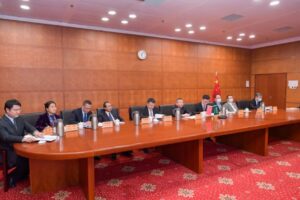Zhang Kejian, administrator of the CNSA, and new ESA Director General Josef Aschbacher, who entered the post March 1, discussed a range of topics according to a short CNSA press release (Chinese).
The parties outlined upcoming activities, with China recently approving a 14th Five-year plan for 2021-2025, and discussed lunar and deep space exploration, Earth observation, and cooperation in ground station.
Josef Aschbacher tweeted after the meeting that he had congratulated Zhang on the Chang’e-5 lunar sample return mission, which in December 2020 delivered to Earth 1.73 kilograms of lunar samples from Oceanus Procellarum on the moon’s near side.
I just met with Mr Zhang Kejian, Head of the Chinese National Space Administration. I congratulated him on the recent recovery of lunar samples through the Chang'e 5 mission. I look forward to the science achievements of this unique mission!
— Josef Aschbacher (@AschbacherJosef) April 1, 2021
Karl Bergquist, ESA’s international relations administrator, told SpaceNews that ESA and CNSA went over ongoing activities including telemetry, tracking, and control support activities for the Chinese exploration program.
ESA assisted both the recent Chang’e-5 and ongoing Mars Tianwen-1 missions with ground station support.
“We have some working groups in the field of Earth observation looking at issues of common interest,” Bergquist said, including data exchange, data for global change monitoring, calibration and validation and more.
Asked about potential involvement in the International Lunar Research Station (ILRS), a project for China and Russia recently signed a memorandum of understanding, Bergquist stated that the CNSA Administrator mentioned the initiative and also reported on the recent agreement with Russia.
The ILRS is understood to initially involve upcoming Chinese robotic Chang’e lander, rover, orbiter and other spacecraft and Russian Luna missions centered on the south pole of the moon. It could be expanded to include more permanent robotic infrastructures and potential crewed visits in the 2030s.
Zhang stated that both China and Russia want the ILRS to be open to cooperation from all nations, including ESA.
Bergquist expects discussions to continue in some form in the future, but at the moment “we have not many details as to the content of the ILRS,” and as such there is “no ESA stance on this topic.”
ESA and China have been discussing cooperation on potential lunar south pole missions in recent years. The two parties earlier collaborated on the Double Star project and are working on the Solar wind-Magnetosphere-Ionosphere Link Explorer (SMILE) mission planned for launch in 2023.



